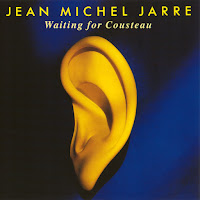 Zoolook (1984)
Zoolook (1984)Jarre goes to town with the Fairlight sampling machine on this studio album featuring - shock horror - shorter tracks with proper titles and (sampled) voices, even. US avant-garde musician Laurie Anderson also features.
Best tracks: Ethnicolor, Zoolookologie.
8/10
Rendez-Vous (1986)
Back to the old 'title track in several parts' formula for this unspectacular album. Very much aimed at the US market and in fact the last 'Rendez-Vous' was to have been played in space by astronaut Ron McNair, tragically killed in the Challenger explosion in January.
Best tracks: Fourth Rendez-Vous, Last Rendez-Vous (Ron's Piece)
5/10
Waiting for Cousteau (1990)
 Into a new decade and with electronic music taking new directions, Jarre was keen to explore the ambient side of things especially on the 47 minute long single pièce on side two, made especially for the CD age (it was edited to half that length for old-fashioned vinyl and cassette tape).
Into a new decade and with electronic music taking new directions, Jarre was keen to explore the ambient side of things especially on the 47 minute long single pièce on side two, made especially for the CD age (it was edited to half that length for old-fashioned vinyl and cassette tape).Best tracks: Waiting for Cousteau, Calypso 1
8/10
Chronologie (1993)
Again it's the 'title track divided into parts' formula although don't let that put you off this impressive return to form. Thus entitled because it started out as a sound made for Swatch adverts.
Best track: Chronologie Part 4
8/10
Hong Kong (1994)
Ten years after Concerts in China here's an even more impressive live album which gives a good idea of Jarre's live repertoire and what could be achieved on stage at this point in time.
9/10
Oxygene 7-13 (1997)
An unexpected follow-up to the majestic opera prima which did not disappoint. Such was the popularity of electronic music at this point that the album spawned several remixes by in-vogue producers and artists, many of which are gathered on the Odyssey Through O2 album.
Best tracks: all
10/10
Metamorphoses (2000)
Into the new century and not content to rest on his laurels, Jarre experiemtns with a number of new styles in an album surprisingly made up of twelve tracks each with a different title. His experimentation doesn't always succeed, although there's obviously a lot here that Jean Micehl had to get off his chest.
Best tracks: C'est la Vie, Tout Est Bleu, Je Me Souviens
7/10
AERO (2004)
If you want to get just one JMJ compilation album (of which there are many) get this one, which is both a collection and re-visitation of various past tracks with upgraded sonics and - if you're lucky - even a DVD with 5.1 sound for good measure. Three new tracks also feature.
Best tracks: Oxygène 4, Equinoxe 3/4, Aerozone
9/10
Téo & Téa (2007)
..and if there's one JMJ album you should avoid it's this one. Derided by both critics and fans alike, it's a highly techno-oriented romp through modern 'dance' sounds and rhythms, describing a day in the life of two computer-generated cartoon characters. Jarre recently said there has some albums he has released which he wishes he hasn't - one feels this may be one of them.
Best tracks: Teo & Tea (and that's saying something)
4/10
Electronica 1: The Time Machine (2015)
.......




